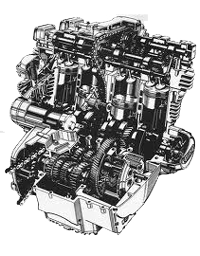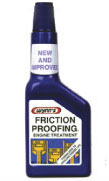PRODUCT IDENTIFICATION
| PRODUCT NAME | EFFECTIVE DATE | PRODUCT CODE |
| Wynn's Friction Proofing Engine Treatment | 12-06-05 | 56301 |
| CHEMICAL NAME | | CAS NUMBER |
| N/A | | N/A |
HAZARDOUS INGREDIENTS
| COMMON NAME | CHEMICAL NAME | CAS NO. | OSHA PEL | ACGIH TLV-TWA |
| Petroleum Hydrocarbon |
Petroleum Oil |
64742-58-1 |
5 mg/m³ |
5 mg/m³ |
Contains no other ingredients now known to be hazardous as defined by OSHA 29CFR 1910.1000(z) and 29CFR 1910.1200.
PHYSICAL DATA
These data are approximate or typical values and should not be used as precise specifications. Unless otherwise noted values are at 20°C(68°F) and 760 mmHg (1 atm).
| Boiling Point/Range |
>600°F(316°C) |
Freeze Point |
15°F(-9.4°C) |
| Specific Gravity (H20=1) @ 15.6°C |
0.89 |
Vapor Pressure (mm Hg) |
N/D |
| Vapor Density (Air =1) |
N/D |
Solubility in Water (%) |
0.1 |
| % Volatiles by Volume |
0 |
Evaporation Rate (Butyl Acetate = 1) |
N/D |
| pH (as is) |
N/A |
pH (dilute) @ % |
N/A |
| Appearance |
Clear thick liquid |
Odor |
Hydrocarbon |
N/D - Not Determined
< = Less Than
N/A - Not Applicable
> = Greater Than
FIRE AND EXPLOSION HAZARD DATA
Flash Point 390°F(199°C) Method Cleveland Open Cup ASTM D-92
Hazard Class Identification
Flammability 1
Health 1
Reactivity 0
Other -
Hazard Code
0 - Least (insignificant)
1 - Slight
2 - Moderate
3 - High
4 - Extreme
Extinguishing Media
Dry chemicals, carbon dioxide, water spray, foam.
Special Fire Fighting Procedures
Use water to cool fire-exposed containers. Fire fighters use a self contained breathing apparatus.
Unusual Fire and Explosion Hazards
Combustion will produce smoke and toxic fumes.
REACTIVITY DATA
Stability
Stable.
Conditions to Avoid
Heat, open flame.
Materials to Avoid
Strong oxidizing agents.
Hazardous Decomposition or Combustion Products
Thermal decomposition may produce oxides of carbon, sulfur, nitrogen, phosphorus, calcium and zinc.
Hazardous Polymerization (conditions)
Will not occur.
HEALTH HAZARDS/ROUTES OF ENTRY
Signs, Symptoms and Effects of Overexposure
Ingestion (swallowing)DO NOT swallow. If swallowed, may cause slight irritation to digestive tract. Signs and
symptoms are discomfort, nausea, vomiting.
Skin Contact May cause irritation to skin. Prolonged contact may cause redness and defatting of skin.
Eye Contact May cause eye irritation.
Inhalation (breathing) Vapors generated at elevated temperatures can cause irritation to respiratory tract.
Other Effects of Prolonged/Repeated Overexposure
This material has not been identified as a carcinogen by NTP, IARC or OSHA. Prolonged and repeated
contact with skin and eyes may cause skin and eye irritation, defatting of skin and redness.
EMERGENCY AND FIRST AID PROCEDURES
Ingestion (swallowing) DO NOT induce vomiting. Give 2-3 cups of water or milk. Call for medical help.
Skin Contact Wash affected area with soap and water. If irritation persists, call for medical help.
Eye Contact Flush eyes with water for 15 minutes. If irritation persists, call for medical help.
Inhalation (breathing) Remove to fresh air to avoid further inhalation.
Comments NOTE TO PHYSICIANS: osure to high concentrations of this
material (e.g. enclosed areas) may be associated with cardiac arrhythmias.
SPILL OR RELEASE CONTROL PROCEDURES
Steps to be taken in case material is released or spilled
Use absorbent sand, clay or vermiculite. Shovel into containers. Prevent liquid from entering into sewers and
waterways.
Waste Disposal Method
Dispose of in accordance with Federal, State and Local regulations.
Environmental Hazard (EPA-CWA, Section 311)
Spills of this material leading to surface waters where it will cause a sheen must be reported to the National
Response Center (800) 424-8802. EPA Reportable Quantity (RQ), 40CFR302 (CERCLA104)
N/A
EPA Toxic Chemical Release Reporting, 40CFR372(SARA313)
| Chemical | CAS NO. | % in Product |
| Hexane | 110-54-3 | 10-30 |
HANDLING AND STORAGE
Handling and Storage Precautions
CAUTION: Contains petroleum oil. Avoid skin and eye contact. Keep containers closed. Use entire contents.
Other Precautions
KEEP OUT OF REACH OF CHILDREN!
PERSONAL PROTECTION - EXPOSURE CONTROL
Ventilation
Normal use, none required. If misting occurs a mechanical or local exhaust is recommended.
Respiratory Protection
Normal use, none required.
Eye Protection
Safety glasses.
Protective Gloves
Rubber, plastic gloves.
Other Protective Clothing or Equipment
None.
Work/Hygienic Practices
Personal cleanliness is always appropriated. Frequent washing minimizes inadvertent exposure.
TRANSPORTATION INFORMATION
Department of Transportation (DOT) Classification
| | Flammable Liquid | | Corrosive |
| | Flammable Solid | | Non Flammable Gas |
| | Flammable Gas | | Non Hazardous by DOT |
| | Combustible Liquid | | Other |
DOT Proper Shipping Name
N/A
DOT ID Number
N/A
DOCUMENTATION
Product Code No.: 56301
Previous Code No.: 56301
Issue Date: 12-06-05
Prior Date: 11-24-97
This information is, to the best of our knowledge and belief, accurate and reliable as of the date compiled. However, no representation, warranty or guarantee is made as to its accuracy, reliability or completeness. It is the user's responsibility to satisfy himself as to the suitability and completeness of such information for his own particular use.
|







